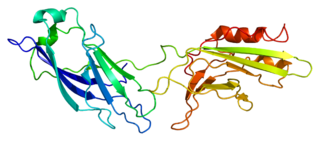Synaptotagmin-1 is a protein that in humans is encoded by the SYT1 gene. [5]
Synaptotagmin-1 is a protein that in humans is encoded by the SYT1 gene. [5]
Synaptotagmins are integral membrane proteins of synaptic vesicles thought to serve as sensors for calcium ions (Ca2+) in the process of vesicular trafficking and exocytosis. Calcium ion binding to synaptotagmin I participates in triggering neurotransmitter release at the synapse. [6] [Supplied by OMIM] [7]
SYT1 is the master switch responsible for allowing the human brain to release neurotransmitters. SYT1 senses calcium ion concentrations as low as 10 ppm and subsequently signals the SNARE complex to open fusion pores. [8]
SYT1 has been shown to interact with SNAP-25, [9] [10] STX1A [11] [12] and S100A13. [13] [14]
Mutations in the SYT1 gene cause a rare neurodevelopmental disorder known as SYT1-associated neurodevelopmental disorder (or Baker-Gordon Syndrome). [15] [16]

Fibroblast growth factor 1, (FGF-1) also known as acidic fibroblast growth factor (aFGF), is a growth factor and signaling protein encoded by the FGF1 gene. It is synthesized as a 155 amino acid polypeptide, whose mature form is a non-glycosylated 17-18 kDa protein. Fibroblast growth factor protein was first purified in 1975, but soon afterwards others using different conditions isolated acidic FGF, Heparin-binding growth factor-1, and Endothelial cell growth factor-1. Gene sequencing revealed that this group was actually the same growth factor and that FGF1 was a member of a family of FGF proteins.

Synaptosomal-Associated Protein, 25kDa (SNAP-25) is a Target Soluble NSF (N-ethylmaleimide-sensitive factor) Attachment Protein Receptor (t-SNARE) protein encoded by the SNAP25 gene found on chromosome 20p12.2 in humans. SNAP-25 is a component of the trans-SNARE complex, which accounts for membrane fusion specificity and directly executes fusion by forming a tight complex that brings the synaptic vesicle and plasma membranes together.

Synaptotagmins (SYTs) constitute a family of membrane-trafficking proteins that are characterized by an N-terminal transmembrane region (TMR), a variable linker, and two C-terminal C2 domains - C2A and C2B. There are 17 isoforms in the mammalian synaptotagmin family. There are several C2-domain containing protein families that are related to synaptotagmins, including transmembrane (Ferlins, Extended-Synaptotagmin (E-Syt) membrane proteins, and MCTPs) and soluble (RIMS1 and RIMS2, UNC13D, synaptotagmin-related proteins and B/K) proteins. The family includes synaptotagmin 1, a Ca2+ sensor in the membrane of the pre-synaptic axon terminal, coded by gene SYT1.

A C2 domain is a protein structural domain involved in targeting proteins to cell membranes. The typical version (PKC-C2) has a beta-sandwich composed of 8 β-strands that co-ordinates two or three calcium ions, which bind in a cavity formed by the first and final loops of the domain, on the membrane binding face. Many other C2 domain families don't have calcium binding activity.

Syntaxin-1A is a protein that in humans is encoded by the STX1A gene.

Synaptosomal-associated protein 23 is a protein that in humans is encoded by the SNAP23 gene. Two alternative transcript variants encoding different protein isoforms have been described for this gene.

Peripheral plasma membrane protein CASK is a protein that in humans is encoded by the CASK gene. This gene is also known by several other names: CMG 2, calcium/calmodulin-dependent serine protein kinase 3 and membrane-associated guanylate kinase 2. CASK gene mutations are the cause of XL-ID with or without nystagmus and MICPCH, an X-linked neurological disorder.

Syntaxin-4 is a protein that in humans is encoded by the STX4 gene.

Vesicle-associated membrane protein 2 (VAMP2) is a protein that in humans is encoded by the VAMP2 gene.

Plasma membrane calcium-transporting ATPase 4 is an enzyme that in humans is encoded by the ATP2B4 gene.

Neurexin-1-alpha is a protein that in humans is encoded by the NRXN1 gene.

S100 calcium-binding protein A13 (S100A13) is a protein that in humans is encoded by the S100A13 gene.

Syntaxin-2, also known as epimorphin, is a protein that in humans is encoded by the STX2 gene.

Regulating synaptic membrane exocytosis protein 1 is a protein that in humans is encoded by the RIMS1 gene.

Synaptotagmin-like 2, also known as SYTL2, is a human gene.

Synaptotagmin-3 is a protein that in humans is encoded by the SYT3 gene.

Synaptotagmin-9 is a protein that in humans is encoded by the SYT9 gene.

Synaptotagmin-7 is a protein that in humans is encoded by the SYT7 gene.

Double C2-like domain-containing protein beta is a protein that in humans is encoded by the DOC2B gene.

Syntaxin 3, also known as STX3, is a protein which in humans is encoded by the STX3 gene.